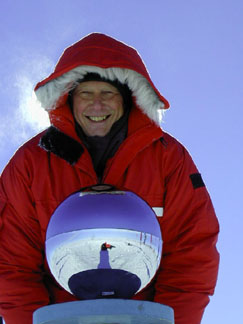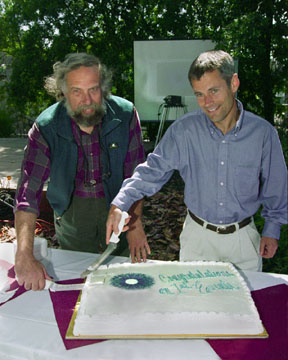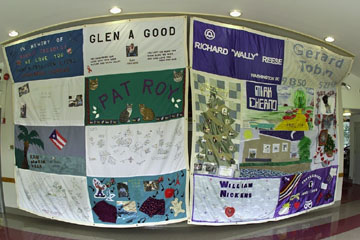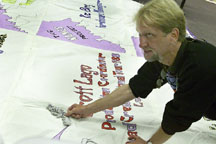|
|
|
| |
|
|
|
- Summer Lectures Series 2000
- Summer Lecture Series Schedule
- Genomic Revolution Grabs Headlines
- Neumark to Head Chemical Sciences
- SNO on Track in Hunt for Neutrinos
- Lab Scientists Win R&D 100 Awards
- A STAR Event
- Washington Report
- Biosciences Award
- Can't Buy You Love
- Correction
- Berkeley Lab Currents
- Berkeley Lab's New CFO: Not Your Basic Accountant
- AIDS Victims: Lest We Forget
- EH&S Classes - June 2000
- Calendar of Events
- Deadlines & Policy For the Calendars
- Exhibits at the Berkeley Art Museum
- Flea Market
- Flea Market Policy
Director Upbeat in State of Lab
By Ron Kolb
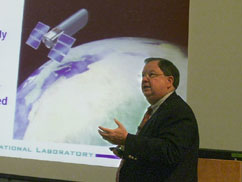 |
Buoyed by a glittering record of achievement and growth, and energized by the prospects of opportunities that lie ahead for the next decade, Berkeley Lab Director Charles Shank delivered an upbeat State of the Laboratory address to employees on Tuesday.
"I look at what we've accomplished in the last decade, and it's a testimony to incredible progress made at the Lab," he said. "It has been one of my great satisfactions to work here. We've done pretty darn well, thanks to all of you here."
In his one-hour annual review of scientific highlights in the auditorium, Shank complimented both the research community, whose world-class production appears regularly on journal covers and in the news, and the support community, who collectively earned an "outstanding" performance rating from Department of Energy evaluators last year.
"And in order to address our vision for the future, we will need all of you," he added.
That vision includes ambitious program growth that will require building space, innovative research that anticipates the scientific challenges of the new millennium, and sustaining budgets from Washington. Although each aspect will require some creative forces to succeed, Shank exhibited a sense of optimism that told his audience anything is possible.
Interspersing results that represented the best research of this past year, he laid out a series of programmatic priorities that respond to what he refers to as "Vision 2010." Elements of that vision include a fully integrated computing capability, new energy sources and environmental solutions, efforts in quantitative biology, research in nanoscience and complex systems, and gaining a fundamental understanding of the universe.
Foremost on this roadmap was the proposed construction and launching of the SuperNova/Acceleration Probe (SNAP) satellite -- "our highest priority project right now," Shank said. "We are playing a major role in astrophysics and understanding the universe. But to take the next step, we have to move toward precision cosmology."
Hence the SNAPSAT, which will move supernova study from ground-based to sky-based observation. A telescope with a billion-pixel camera will record supernova bursts in greater numbers than ever at never-before-seen precision. The interagency project is currently circulating before prospective funders in Washington.
Shank also mentioned the 88-Inch Cyclotron (he affectionately called it the "elderly beast") as a site for future programs, which will include the newly reinstalled Gammasphere and proposed upgrades that could turn the cyclotron into a stable beams facility for nuclear physics.
At the center of Berkeley Lab's aspirations for exploring the nanosciences is the Advanced Light Source, an already productive facility that Shank said will triple its number of users in the next decade. On the drawing boards is a user and nanoscience building projected for construction adjacent to the present dome on the east side.
"Daniel Chemla and his team have enabled the ALS to move from the problems of the Birgeneau Report to a whole new facility with very positive reviews," the Director said. "They have positioned us well for going into the future." That future included a significantly expanded protein crystallography program with at least eight beamlines, superbend magnets to extend the flux and brightness of the machine, and a femtosecond pulse x-ray facility.
In light of the announcement on Monday concerning the completed rough draft of the human genome sequence, Shank said the Laboratory, and the world, stand "on the threshold of a new biology." Building upon its "amazing productivity in the biological sciences," Berkeley Lab is poised to play a major role "in a world in which sequence and structure will lead to a new understanding of function," he said. That means an integration of the physical, computing and engineering sciences to create the tools that will allow post-sequence data collection and analysis.
With the National Energy Research Scientific Computing Center already among the nation's fastest unclassified facilities, Shank spoke about his vision of building the world's most powerful open computer facility on the Berkeley Lab site -- perhaps where the decommissioned Bevatron now sits. In the meantime, NERSC and much of the computing hardware will move to a leased downtown Oakland building this fall.
Shank also commented on the Laboratory's upcoming work in the areas of energy and the environment, especially efforts to reduce carbon emissions as well as to capture and sequester atmospheric carbon. "We want to help answer the questions of what to do with the carbon in the atmosphere, and how to manage carbon dioxide in the future," he said, pointing to state partnerships on energy efficiency and electricity reliability, and the Lab's investigations into oceanic and geologic sequestration.
As for budget and politics, Shank expressed caution and hope. Early markups in Washington indicate soft support for DOE science, and the impending change in administration adds to the uncertainty. However, for hope he can always look to history: over the past 10 years, Berkeley Lab has enjoyed an inflation-adjusted 42 percent growth in the budget.
Shank also pointed to three challenges that represent his top personal priorities -- space, safety, and diversity.
"We're getting more money," he said of the first item, "but many people find it difficult to find a place to sit. We have to create more high-quality space for people to do the science," which is difficult in a land-restricted environment like Berkeley Lab.
In the area of safety, he complimented the Lab for being the first to implement a validated Integrated Safety Management plan. On the other hand, he pointed to a graph which showed accident rates creeping up over the past two years. "I want you all to think about safety and our important commitment to this," he told the audience. "We've got much to do in this area."
And much is left to do in the area of improving workforce diversity. According to the director, "we've reached a compliance level, not a leadership level." He urged all to participate in broadening hiring pools, and he especially challenged division directors by requiring each to submit aggressive diversity plans for his review and approval. "This is a public institution," Shank said, "and we should be leaders in this area." He described the Lab's diversity hiring performance to date as "flat."
He concluded by commenting on the recent news attention given to security and project management concerns at the two defense labs and on what this might mean to Berkeley Lab's management contract with the University of California. He noted that each lab has its own contract with UC, not all three in one.
"I am optimistic that we won't face the same prospects (for restrictions) as the other labs," Shank said. "I also believe that all three contracts will continue with UC." He pledged to resist any attempts to impose policies or procedures that could change the nature and character of Berkeley Lab as open, unclassified, and welcoming of diverse viewpoints.
State of the Lab on the Net & on Video
A replay of Director Shank's State of the Lab address can be viewed via video stream on the Internet. To access it, look up the Lab's "StreamStation" page at lbl-web.lbl.gov; click on the "recorded meetings" icon and select the presentation. At the prompt enter your initials (no password is required) and then click on "view." Version 7 or higher of RealPlayer Basic software is required and can be downloaded from http://www.real.com/player/index.html?src=000619realhome_1.
Videotaped copies of the talk are also available for loan from the Lab Library in Bldg. 50.
Summer Lectures Series 2000
By Jeffery Kahn
A broad spectrum of science -- the engineering of cell surfaces, a cosmic observatory beneath the South Pole, a play-by-play video of cell dynamics, the breakdown of cell communication and cancer, and storage of carbon dioxide in the ocean -- will be explored during Berkeley Lab's 2000 Summer Lecture Series.
The annual series begins Wednesday, July 5 and continues on four successive Wednesdays. The one-hour lectures are geared to a general audience and open to all employees, summer students, teachers, and visitors. Audience members often bring their lunches to the talks, which take place at noon in the Bldg. 50 auditorium.
• Carlos Bustamante will kick off the series on July 5 with a presentation on molecular machines. A biophysicist, Bustamante heads the Advanced Microscopies Department for the Physical Biosciences Division and is a member of the UC Berkeley Physics Department.
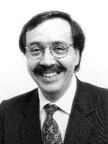 |
• On July 12, Bob Stokstad of the Nuclear Science Division takes his audience on a vicarious journey to the South Pole, site of AMANDA, a high-energy cosmic-neutrino "telescope." As Stokstad will detail, neutrinos provide an almost ideal new way of seeing distant realms of the cosmos.
While dust clouds and other phenomena in the Universe absorb or scatter the photons, neutrinos are immune to both electromagnetism and the strong nuclear force, able to escape just about anything other than a black hole. Though they travel virtually unimpeded across the cosmos, neutrinos are just as hard to catch as they are to stop. At the South Pole, researchers are hoping to develop an even larger array of neutrino detectors to be buried within a cubic kilometer of ice that collectively would compose a telescope able to see what light-dependent telescopes cannot.
• On July 19, Mary Helen Barcellos-Hoff of the Life Sciences Division will discuss the effects of radiation on cell-to-cell communications.
Specifically, the Barcellos-Hoff Laboratory looks at how radiation affects the way cells communicate with one another and with their environment (extracellular matrix, growth factors and hormones) and how a breakdown in this communication can lead to cancer. The focus of her research has been breast cancer.
|
|
"One of our primary goals is to take control of the cell surface," says Bertozzi.
She and her colleagues have found a way to use natural biological processes to plant artificial markers on the surfaces of living cells. Already, Bertozzi's group has used these techniques to turn cancer cells into targets for diagnostic probes and cell-killing toxins. In addition, principles learned from the molecular analysis of cell surfaces are being adapted to the design of novel materials for biomedical applications. For instance, cell markers can be engineered to control cell adhesion to the materials used in pacemakers and artificial organs.
• The lecture series will wrap up on August 2 with a talk by the Earth Sciences Division's Jim Bishop on climate change and a project to investigate the storage of atmospheric carbon dioxide in the ocean.
Bishop, a chemical oceanographer and marine geochemist, is codirector of DOE's Center for Research on Ocean Carbon Sequestration.
The Center was created to evaluate and assess the feasibility, effectiveness and environmental ramifications of sequestering vast additional quantities of C02 in the ocean. Bishop will discuss potential sequestration strategies -- direct injection and fertilization-- and outline research that will advance our understanding of the ocean carbon cycle and allow us to understand the effects of proposed sequestration strategies on this system.
The Summer Lecture Series is sponsored by the Public Information Department.
Summer Lecture Series Schedule

Genomic Revolution Grabs Headlines
By Monica Friedlander
Time magazine had it on its cover; news shows led their broadcast with it; and President Clinton called the enterprise "the most important, most wondrous map ever produced by humankind."
This "map" of the more than 3 billion letters -- or base pairs -- of chemical information that comprise our genetic code is not yet complete. But scientists have come close enough to that goal to ceremoniously announce that the first rough draft of the human genetic code has been sequenced.
On Monday morning, President Clinton held a press conference in which he hailed both public and private efforts leading to this biomedical achievement, which promises to one day change the face of medicine.
The momentous event was further magnified by the fact that the leaders of the two principal and competing efforts to sequence the human genome -- the international Human Genome Project, originally initiated by the U.S. Department of Energy, and Celera Genomics, Inc. -- were both present to announce that they have separately reached major milestones in the decade-long quest to decipher what's commonly referred to as the instruction book of human life.
The international Human Genome Sequencing consortium, which includes the Joint Genome Institute of which Berkeley Lab is a collaborator, announced the assembly of a "working draft" of the human genome sequence -- the decoding of 97 percent of the genome's letters. Celera, a Rockville, Maryland-based company, has completed its own "first assembly" of the human genome DNA sequence using a different approach.
Monday's announcement, said Energy Secretary Bill Richardson, "is an extraordinary accomplishment involving the creative efforts of thousands of scientists from all over the world over a period of 14 years ...I am extremely proud of the Department of Energy's role in the publicly-funded human genome effort, from initiating the human genome program in the 1980s to completing the draft sequence of three chromosomes last April."
DOE Diplomacy
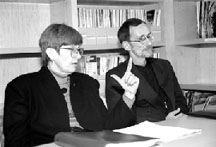 Ari Patrinos, pictured above with Martha Krebs during a visit to Berkeley Lab, directs DOE's share of the genome project and recently helped bring together the heads of the public and private sequencing groups. |
These differences involve not merely methodology, but issues such as who should get most of the credit, whose work is more accurate and complete, and how -- if at all -- the information should be shared and publicized.
On May 7 Patrinos brought Collins and Venter together at his Rockville, MD, home over pizza and beer. Two more meetings followed before the two agreed on a framework for Monday's joint announcement. Publication will follow later in the year.
While the rivalry between the two groups received much play in the media, each side has in fact contributed in its own way to the success of the other. The Human Genome Project, for instance, is using Celera's advanced sequencing machines, while Celera, which protects the corporate rights to its results, has most likely benefitted from the information continuously made available on the Internet by the Human Genome Project.
The efforts of the two groups involve different sequencing approaches, having to do with the way that either the entire genome or fragments of DNA are first shredded, then overlapped, sequenced, and reassembled.
While they may disagree on the preferred method, there is clear merit to both. And both of them align the sequence along the human chromosomes using landmarks contained in the physical map produced by the Human Genome Project.
"The two approaches are quite complementary," said Collins. "In the end, the best approach may well be to use a combination of the methods for sequencing future genomes."
The "working draft" version of the Human Genome Project sequence contains gaps and ambiguities, which the project hopes to eliminate in the finished sequence. This ultimate goal was projected to be accomplished by 2003, although the current results could mean that the desired 99.99-percent-accurate draft could be produced well ahead of schedule.
The pace of genome sequencing has rapidly accelerated over the past year, with more than 60 percent of the consortium's sequencing having been produced in the past six months at the rate of 1000 bases a second, 24 hours a day, seven days a week.
Greatest challenge lies ahead
President Clinton has committed himself to accelerating efforts to translate the information gleaned from the genetic blueprint into medical advances. These are expected to range from identifying individual predisposition to disease and developing life-saving drugs, to banishing cancer and lengthening the human life span.
The White House press conference was held in tandem with a similar ceremony led by British Prime Minister Tony Blair to underscore the international nature of the enterprise.
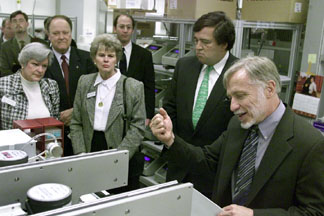 JGI director Elbert Branscomb gives Energy Secretary Bill Richardson a tour of the Walnut Creek facility, one of five largest in the public Human Genome Project consortium. |
The total cost for the working draft is approximately $300 million worldwide, with roughly half of that being funded by the U.S. National Institutes of Health.
The achievement announced on Monday -- placing the letters of the human genetic alphabet in correct order -- is just the beginning, however. Yet to come is identifying the proteins made by the genes and their respective functions in order to better understand what the code means and how we can control it to better our lives.
Said Elbert Branscomb, director of the JGI, "Now our task becomes even more challenging -- to convert our draft sequences into finished form, and then to explore the myriad of applications of this information for the benefit of humankind. We at JGI look forward to the next phase, to working with our public and private collaborators in assembling the first book of human life and translating it in ways that will assist in the diagnosis, treatment and eventual prevention of disease."
Neumark to Head Chemical Sciences
By Paul Preuss
Berkeley Lab Director Charles Shank has appointed Daniel M. Neumark director of the Chemical Sciences Division (CSD). Neumark succeeds C. Bradley Moore, who is leaving to take a new post at Ohio State University (see Currents, Feb. 11).
"I welcome Dr. Neumark's creativity and enthusiasm in leading the Chemical Sciences Division," said Shank, noting that "the background, talent, and skills of Dr. Neumark are particularly well suited to this assignment." In announcing the appointment Shank also expressed his appreciation "for the dynamic leadership of Dr. Moore."
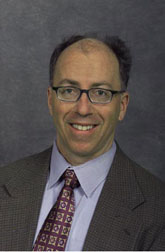 |
Neumark grew up in Chicago and remembers being attracted to science as a child but only choosing to make a career of chemistry after being inspired by high school teacher Frank Cardulla, who recently won the American Chemical Society's James Bryant Conant Award as the best high school chemistry teacher in the country. Cardulla was a good model; Neumark has gone on to receive numerous scientific awards and fellowships, including the Camille and Henry Dreyfus Teacher-Scholar Award in recognition of his own educational contributions.
At Harvard Neumark studied under Dudley Herschbach, and at Berkeley his advisor was Yuan T. Lee -- two pioneers of research with crossed molecular beams who, with John Polanyi, shared the 1986 Nobel Prize for their work in chemical reaction dynamics. "From them I really caught the crossed molecular beam bug," Neumark says.
A physical chemist whose research is concentrated on molecular structure and dynamics, Neumark is well known for his experimental studies using negative-ion photoelectron spectroscopy to probe the transition state in chemical reactions.
"In chemical reactions atoms collide, rattle around, and fall apart on a femtosecond time scale," he explains. "We start with negative ions as a precursor to the transition state. Because they are charged we can select their size with precision."
With related techniques Neumark has also studied the electronic and vibrational states of small clusters of atoms, including commercially important semiconductors, and has investigated the dynamics of both negative ions and clusters on the femtosecond time scale.
His research into the dissociation of free radicals has been important to the Department of Energy's program to study the fundamentals of combustion. At the Advanced Light Source and in his own laboratories, Neumark has used crossed molecular beams to study hydrocarbons that play a vital role in combustion and interstellar chemistry.
Among his first priorities as new director of Berkeley Lab's CSD, Neumark plans to "get a grip on all the varied sciences in the division" in order to effectively represent the division's programs in Washington. With some two dozen scientists and staff, over half of them with joint appointments at the university, the division represents a very wide range of interests and approaches to chemistry, from theory to application.
Neumark says an immediate problem is that "we are faced with the loss of good people" like Brad Moore, "and one of my priorities is to make constructive use of these losses" by seeking replacements who can best contribute to the division.
Beamline 9.0.2 at the ALS represents a unique opportunity and challenge for the CSD. "Physical chemists like to stay in their labs and play with their lasers," Neumark says with a smile. "Our job is to convince people to use this marvelous tool." To this end, Neumark welcomes the arrival of Tom Baer from the University of North Carolina as beamline director.
The beamline's three endstations are tailored for investigations of chemical dynamics and "open possibilities for investigation that didn't exist five years ago," says Neumark. "They make it possible to do experiments here that can't be done anywhere else."
"Chemistry's tradition at Berkeley Lab goes back to the beginning, and it's wonderful to be part of an established program. It will take effort to maintain that tradition," says Neumark, "but maintenance is not enough -- we have to build on it as well."
SNO on Track in Hunt for Neutrinos
By Lynn Yarris
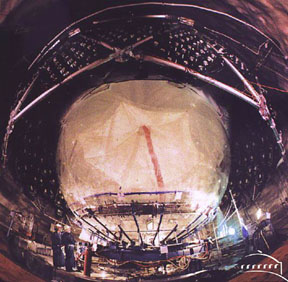 |
"The Sudbury Neutrino Observatory (SNO) works well and clearly observes solar neutrinos!"
That was the conclusion of a report on the first six months of operation of this most unique telescope, located in a cave more than a mile underground outside Sudbury, Canada, and run by an international collaboration that includes researchers from Berkeley Lab and 10 other laboratories and universities in the U.S., Canada, and the United Kingdom.
The report was released on June 16 at "Neutrino 2000," the 19th international conference on neutrino physics and astrophysics, held at Laurentian University in Sudbury, Canada.
Kevin Lesko, a physicist with the Nuclear Science Division (NSD) who leads Berkeley Lab's SNO effort, was one of nine Lab members to attend the conference. "From the audience reaction," he said, "it was clear that the audience was very impressed with how clean the data are (how low the backgrounds) and the thoroughness of the analysis procedures being conducted by the collaboration. Several of the audience members, after having taken the tour of the underground facility and viewing the initial data, had found new appreciation for the efforts taken in constructing the detector under such challenging conditions."
SNO's mission is to answer some of the most perplexing questions about neutrinos, the ghostlike particles emitted from the sun and supernovae, which are the second most common yet perhaps the most mysterious particles in the universe. Neutrinos interact so rarely with other matter that one could pass untouched through a wall of lead stretching from the earth to the moon. It is estimated that the sun bathes each square centimeter of Earth's surface with billions of neutrinos a second, yet scientists don't know how much a single one weighs.
With its exclusive ability to detect and measure the properties of all three known types of neutrinos, SNO is expected to help answer questions about neutrino mass and why previous experiments have not detected as many solar neutrinos as expected. These results should shed new light on the nature of matter at the smallest scales, as well as on the structure of the stars and of the universe as a whole.
Researchers with NSD and the Engineering Division designed and built the panel arrays which house SNO's 9,600 photomultiplier tubes -- ultra-sensitive light-sensors which are the heart of the experiment.
To reduce background radiation "noise," SNO is located in a mine two kilometers underground and uses heavy water, which is a billion times cleaner than ordinary tap water in terms of natural radioactivity. The SNO experiment will last at least 10 years and is expected to record as many as 20 neutrino events each day.
In addition to Lesko, members of Berkeley Lab's SNO team are senior staffers Bob Stokstad and Rick Norman, plus Yuen-dat Chan, Xin Chen, Alysia Marino, Noah Oblath, Colin Okada, Yekatrina Opachich, and Alan Poon.
Lab Scientists Win R&D 100 Awards
Two Berkeley Lab researchers were honored with this year's prestigious R&D 100 Awards for their development of outstanding technologies. Since 1963 R&D Magazine has showcased the 100 best ideas in industrial and technical innovation with these annual awards, often referred to as "the Oscars of Invention."
The Lab recipients are:
- Lara Gundel of the Environmental Energy Technologies Division for
development of Fine XAD Sorbent Coating for pollution control and
monitoring. The coating removes organic vapors from the air, greatly
improving measurement accuracy for semivolatile and particulate
contaminants.
- Xiao-Dong Xiang of Environmental Energy Technologies and Peter Schultz, formerly of Materials Sciences, for Combinatorial Synthesis, a technology for accelerating discovery of new materials with improved properties. The entry was submitted in conjunction with Symyx Technologies, Inc.
A STAR Event
|
|
Preparing
to cut the cake that celebrated the success of the STAR detector
system in recording the first collisions at RHIC are Jay Marx of the
Nuclear Science Division (left) and Engineering Division's Bill
Edwards, who served as the project's director and deputy director,
respectively.
The first collisions were recorded at Brookhaven on June 12. The
ceremony at Berkeley Lab was held last Thursday on the stage outside
the Lab cafeteria. |
Washington Report
Congressional Outlook Hazy on Global Climate
A Congressionally mandated three-year assessment of the effects of global climate change has concluded that the United States will be a warmer place and that this will affect everything from the western snowpacks that supply California with water to New England's fall foliage. Much beyond that, however, the models simply cannot say with any degree of certainty."If anything is certain," says Thomas Karl, director of the National Oceanic and Atmospheric Administration's National Climatic Data Center in Asheville, N.C., and a co-chair of the committee that pulled together the assessment, "it's that the past isn't going to be a very good guide to future climate."
The assessment was based on two state-of-the-art climate models -- one from the Canadian Climate Center and one from the U.K. Hadley Center for Climate Research and Prediction. Both models couple a simulated atmosphere and ocean but each solves the problems of simplifying a complex world in different ways. This led to dramatically different predictions for the future U.S. climate.
For example, the Canadian model foresees the cornfields of Kansas as being gripped by severe and frequent droughts, whereas the U.K. model projects those same fields as being doused with more rain than ever.
Overall, the assessment concludes that the productivity of American agriculture will remain high and should increase throughout the 21st century. However, there will be regional winners and losers depending on how well each region adapts to climate change.
Critics, who note that Congress mandated this assessment but failed to fund it, do not put a great deal of stock in the results. "You get what you pay for," said one climatologist.
The report, "Climate Change Impacts on the United States," can be viewed at http://www.nacc.usgcrp.gov/.
Maryland Number One
When it comes to per capita spen-ding of federal R&D funds, Maryland leads the country. At a whopping $1,573 per head, the state of the Baltimore oriole and the black-eyed Susan dwarfs the per capita federal R&D funding of such technology heavyweights as California ($441) and Massachusetts ($587). Last year, Maryland received a total of $8.1 billion of the $80 billion federal research budget, second behind California, which, thanks to the national labs, took in $14.4 billion. But Maryland has less than one-sixth the population of California.These figures are presented in a 650-page report issued by RAND's Science and Technology Policy Institute in Arlington, VA.
Other prime beneficiaries of federal R&D spending were New Mexico ($1328), Georgia ($580), and Alabama ($541). Ranking at the bottom was Kentucky, with $29 per person. -- Lynn Yarris
Biosciences Award
Jay Groves, who joined the Physical Biosciences Division as a Director's Postdoctoral Fellow, has won a Burroughs Wellcome Fund Career Award in the Biomedical Sciences, one of 26 awardees this year in the U.S. and Canada. The award program, started in 1995, encourages the development of biomedical researchers who are in the early stages of their careers and helps them make the transition to independent investigators.
Can't Buy You Love
All over the Hill, as supervisors and employees are scrambling to complete their P2R forms, it might interest everyone to know that, according to a new report from the National Science Foundation, there is little correlation between pay raises and job satisfaction. This is especially true if you're a physicist, says NSF.
According to the biennial NSF report, "Science and Engineering Indicators 2000," physicists who earned their Ph.D.s within the past five years get larger raises than other scientists but are more likely to regret their career choice. Life scientists, on the other hand, get smaller raises but have fewer regrets. The median salary for recent Ph.D. graduates was $41,000 in 1997, with a high of $72,000 for private-sector computer scientists and a low of $27,000 for biology postdocs. New physicists pulled down $43,000, compared with $32,000 for biologists.
The latest, two-volume version of Indicators now comes with a CD-ROM and is on the web at http://www.nsf.gov/sbe/srs/stats.htm/.
Correction
In our front-page story on the Spallation Neutron Source in the last issue of Currents (June 15), the name of physicist Rainer Thomae was misspelled. We regret the error and any inconenience it may have caused.
Berkeley Lab Currents
Published twice a month by the Public Information Department for the employees and retirees of Ernest Orlando Lawrence Berkeley National Laboratory. Ron Kolb, PID department head.EDITOR: Monica Friedlander, (510) 495-2248, msfriedlander@lbl.gov
STAFF WRITERS: Paul Preuss, (510) 486-6249; Lynn Yarris, (510) 486-5375
CONTRIBUTING WRITERS: Jon Bashor, X5849; Allan Chen, X4210, Jeffery Kahn,
X4019
FLEA MARKET / CALENDAR: 486-5771 fleamarket@lbl.gov / currents_calendar@lbl.gov
Public Information Department, Berkeley Lab, MS 65A
One Cyclotron Road, Berkeley CA 94720
Tel: 510/486-5771 Fax: 510/486-6641
Berkeley Lab is managed by the University of California for the U.S. Department of Energy.
Berkeley Lab's New CFO: Not Your Basic Accountant
By Ron Kolb
New Chief Financial Officer Bill Wasson has the letters "C.P.A." behind his name, but don't let that fool you. By his own admission, he's not your traditional "debit-and-credit accountant."
"I love to build things," he says with a drawl, the most obvious artifact of a lifetime spent in Texas - except for the four weeks he's been Berkeley Lab's top financial manager. And with that, he brings a legacy of experience to California that has served some of the Lone Star State's top educational institutions quite nicely.
Take Texas A&M, for example. When he arrived at College Station fresh with his business administration degree in 1970, Wasson set to work in the Treasurer's office. Just months after he arrived, the University President suffered a stroke and died, and his grand vision of growing programs and prestige was left to Wasson's boss to execute. Wasson's rise up the ladder of responsibility was, of necessity, faster than even he had anticipated.
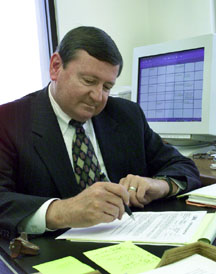 Bill Wasson in his downtown office. |
Then there was the Institute of Biosciences and Technology at the Houston Medical Center, which Wasson administered through financing and construction. And the rebuilding of Prairie View A&M, which he helped to put on firm financial and infrastructure grounds after it faced a $5 million deficit.
Not your basic accountant.
Perhaps even more telling is Wasson's master's degree -- in liberal arts.
"I went back and got it, after 20-plus years of working, in 1990," he recalls. "I realized that in this business, people skills are so important. You have to be able to discuss something other than what you did at work." His first love, in fact, is European history, in particular Victorian England.
This breadth of experience and interest should serve Berkeley Lab well. Wasson is taking over a position that has been vacant (except for Deputy Director Klaus Berkner's acting service) for more than a year, assuming responsibility for tasks in the controller's office, procurement, and sponsored projects.
"Klaus has indicated he wants outreach into, and good communications with, all divisions, and an environment in which employees can grow and prosper," Wasson said. "We need succession planning, education and development. I want us to be very focused on people, not where we're continually looking for someone to fill a position and never planning ahead."
At UT Medical Branch, Wasson completely redesigned administrative systems and made operations more efficient and customer-oriented -- goals that are consistent with Berkeley Lab's objectives. "It was a culture that had to learn that scientists and physicians were customers, too," he said. "We established a flattened, team-based organization focused on the customers."
And in the short time he's been here-- even while Julie, his wife of 32 years, waits for the moving company to find and deliver their housewares, stuck somewhere between here and Lubbock -- Wasson is making his rounds with prospective customers. On top of the agenda is to visit all division directors. "I need to focus my attention on assessing the overall Lab institution, getting outside the walls of the CFO's office. It's time-consuming but interesting; you can't guess what people need," he said.
He will also be focusing on financial systems, which he says tend to change with new technology every three to five years. "It will be a continually rolling process," Wasson said. "We'll use a process refinement model, to keep them simple and cross-functional."
Although Wasson leaves two sons -- one in college, one fresh out of law school -- and heritage in Texas, he says he looks forward to the challenges that a new lifestyle and a new institution will bring. "It's not the largest place I've been," he says of Berkeley Lab, "but it is more complex. I had 17,000 people at the UT Medical Branch, and a $1 billion budget. I believe that the experience there, diverse in the people and the situation, will be helpful here."
AIDS Victims: Lest We Forget
|
|
|
A few of the more than 45,000 individual panels that make up the AIDS Memorial Quilt hung in the cafeteria lobby last week, a touching reminder of the human side of the tragedy that has taken some 700,000 lives in the U.S. alone. The exhibit was part of the Lab's observance of Gay Pride Month and was hosted by the Gay, Lesbian, Bisexual, Transgender and Friends Employee Activities Association.
On Friday, June 23, Rick McCormick of the national chapter of the Names Project, which sponsors the quilt, gave a presentation in Perseverance Hall. He talked about the history of the quilt and presented a video of "Lest We Forget," a film about the display of the quilt in Washington, D.C. in 1996. That was the last time such an exhibit was still possible, he said, as no place could hold the entire quilt any more. The video ended with a grim and poignant reminder: "People are still dying. The quilt is growing."
Although the event was part of Gay Month activities, McCormick reminded everyone that there is nothing intrinsically gay about the AIDS epidemic. "AIDS is a disease, folks. It has no prejudice."
LabVIEW and PXI Tutorial
National Instruments will be hosting a LabVIEW Tutorial on Tuesday, Aug. 1 from 1:30 to 3:30 p.m. in Perseverance Hall. The session will cover LabVIEW Graphical Programming and the instrumentation platform PXI. PXI-Scopes and PXI-Waveform Generators will be controlled and automated by LabVIEW during the tutorial.
To register, call (888) 444-3539. For more information on LabVIEW or PXI, see http://www.ni.com/labview or http://www.ni.com/pxi.
HR and Benefit Forms Online
The Human Resources Department has enhanced its website to include an Online Forms page at http://www.lbl.gov/Workplace/HumanResources/forms/.
Employees may download benefit claim forms, payroll withholding and direct deposit forms, P2R forms, employee development and training forms, foreign scholar forms, worker compensation forms and many more.
Family Day at Great America
Tickets are being sold at the cafeteria entrance every Tuesdays from 12 to 1 p.m. for the Family Day at Great America. Employees may purchase tickets for Aug. 12 or 13.
The event is sponsored by the Employees' Activity Association. Admission is $11.50 for adults and children seven and older, $10 for children aged three to six, and free for those under two. Lab employees must show their LBNL badge to purchase tickets. Checks should be made payable to UC Regents.
For more information contact Lisa Cordova at X5521.
Courier Services
The Facilities Department provides rush courier service with pick-up and delivery both on- and off-site. Transportation can deliver up to 2,000 pounds in the Bay Area or in central or northern California. Onsite materials will be delivered within one hour. For pick-up call X5404.
Courier service (two-hour, four-hour, same day, and rush) is also available from IDS Courier, which operates 24 hours a day and provides pick-up and delivery anywhere in the Bay Area and in parts of northern and central California. For information call 548-3263.
Office Products Reuse Program
Once again Lab employees may pick up a variety of office products every Wednesday during lunch time (11:30 to 1:30) in the cafeteria lobby. Items likely to be available will include binders, desktop organizers, file folders, staplers, tape dispensers, envelopes, and more.
All items are free to employees for use at Berkeley Lab. Questions regarding this program may be directed to Shelley Worsham at X6123.
Summer Intern Picnic
For the seventh time Berkeley Lab will be hosting a summer student picnic on Friday, July 21 from 12 to 1 p.m. on the patio area between Bldg. 2 and Bldg. 6 (the ALS). Hundreds of interns, mentors and other Lab employees have gathered in past years for this student celebration. Barbecued food and musical entertainment will be provided.
The event recognizes the efforts of all those who are contributing to the Lab's summer intern programs, which are coordinated by the Center for Science and Engineering Education.
The picnic is funded by the Employees' Activities Association with assistance from the Latino and Native-American Association (LANA), the Gay, Lesbian, Bisexual, Transsexual and Friends (GLBTF) Association, and the African American Employee Association (AAEA).
LBNL Softball Club
Standings after five weeks of play:
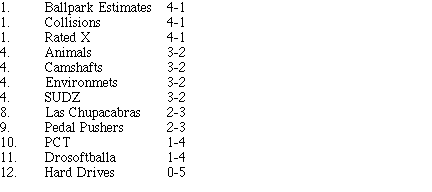
Hall of Science July Fourth Bay Cruise—
Science Fun Days All Summer Long
The Lawrence Hall of Science is inviting everyone to sail under the stars with its Fourth of July Bay Cruise from 7:30 to 10:45 p.m. on Tuesday, July 4. Climb aboard and enjoy family entertainment and a perfect view of Bay Area fireworks -- and also support a good cause: proceeds from the cruise benefit the Lawrence Hall of Science and its educational program.
The Blue and Gold Fleet vessel departs at 7:45 sharp from Jack London Square in Oakland. For additional information and reservations call the Hall of Science at 642-5132.
Meanwhile, don't forget that Wednesdays are Summer Science Fun Days at the Hall of Science, with special events organized every week. Among them: Asia FantAsia presentation on July 5, Ice Cream Day on July 12, making musical instruments on July 19, solids, liquids and gases on Aug. 2, Kites Kaleidoscope on Aug. 9, and much more.
To learn about LHS's Summer Science Fundays, Experiment Gallery, and a variety of other fun activities look up the LHS website at http://www.lhs.berkeley.edu.
EH&S Classes - June 2000
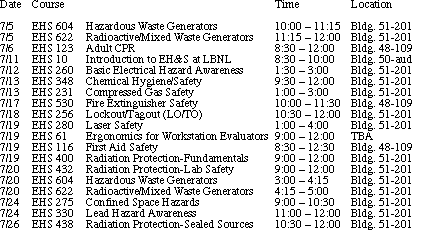
Please Note: The schedule for the second half of July has not been finalized yet. Please check the EH&S training schedule website at http://www-ia1.lbl.gov/schedule and/or the next issue of Currents for updated information.
For more information or to enroll, contact Susan Aberg at Saberg@lbl.gov or enroll via the web at http://www-ehs.lbl.gov/ehstraining/registration/. Preregistration is required for all courses except EHS 10 (Introduction to EH&S).
Calendar of Events
June 30 - July 16, 2000
General Interest Calendar
WED., JUNE 5
SUMMER LECTURE SERIESCarlos Bustamane kicks off series 12 p.m, Bldg. 50 auditorium
THURS., JUNE 6
SHOEMOBILE7:30 - 3:30, cafeteria parking lot
TRIPMOBILE
11:30 - 12:40, cafeteria parking lot
TUESDAY, JUNE 11
NEW EMPLOYEE ORIENTATION9 a.m., Bldg. 50 auditorium
WED., JUNE 12
SUMMER LECTURE SERIESBob Stokstad on South Pole neutrino telescopes 12 p.m, Bldg. 50 auditorium
FRI., JUNE 14
FIDELITY RETIREMENT SESSIONSBldg. 65 conf. rm., call (800) 642-7131 for appointment
FRI., JUNE 21
SUMMER INTERN PICNICNoon, Bldgs. 2 & 6 patio area
Seminars & Lectures
THURS., JULY 6
PHYSICS DIVISION RESEARCH PROGRESS MEETING"MONOLITH, Atmospheric Neutrino Detector" will be presented by Stephano Ragazzi of the University of Milan.
4:00 p.m., Bldg. 50A-5132
Refreshments at 3:40
A list of upcoming Physics Division research progress meetings is available online at http://www-physics.lbl.gov/seminars/rpm.html.
Deadlines & Policy For the Calendars
The deadline for submitting items for both the general calendar and for Seminars and Lectures is always 5 p.m. the Monday of publication week. Currents is published every other Friday.
Items may be e-mailed to currents_calendar@ lbl.gov, faxed to X6641, or mailed to Bldg. 65B.
The deadline for the July 14 issue is 5 p.m. Monday, July 10.
Exhibits at the Berkeley Art Museum
The Berkeley Art Museum & Pacific Film Archive, run by the University of California, is featuring a variety of exhibits and displays throughout the summer, some of which are ending this weekend.
Master of Fine Art Graduate Exhibition
Through Sunday, July 2
The 30th Annual MFA Exhibition
Through Sunday, July 2
Mandala: The Architecture of Englightenment
July 19 through Sept. 17
The museum galleries are located at 2626 Bancroft Way in Berkeley.
For more information call 642-0808 or visit the BAMPFA website at http://www.bampfa.berkeley.edu/exhibits/.
Flea Market
Autos & Supplies
'99 Honda SUV, less than 10K mi, black, mint cond, V6 3.8L, ac, pwr steer/wind/door, stereo/cass, cruise, dual airbags, $23,000/bo, Tamra, X2783`93 JEEP GRAND CHEROKEE, 4.0, 5 sp 105K mi, $8,900/bo, Lucia, 235-3417, X2301
`93 MERCURY SABLE GS Sedan, 4 dr, auto, 81K, mi silver, exc cond, super clean, V6 3.8L, ac, pwr steer/win/door/seat, stereo/ cass, cruise, dual airbag, new alarm, maint records avail, free accessories, $5,600/bo, Yang, X2412, 558-0579 (after 8 pm)
`92 BUICK REGAL, 4 dr, auto, 3.1 L/6 V, 148K mi, ac, pwr steer/ win/locks, tilt wheel, cruise, air-bag, exc cond, $3,500/bo, Victor, 642-4894, Tali, 527-7969
`92 TOYOTA TERCEL, 2 dr sed-an, 105K mi, good cond, $2,900/ bo, X2370
`89 HONDA CIVIC 3D, 4 dr, 105K mi, ac, stereo, $3,300, Andre, X7870, 848-2161
`87 OLDS MOBILE CIERA, new tires, transmission just tuned up, white, stereo, $2,500, Alessandro, X4795, 845-4672
`83 BMW 633csi, 5 spd, new tires, Sony CD stereo, sunroof, silver, dk blue leather interior, 125K mi, runs great, $5,000, Roy, X5731
`79 CHRYSLER CUTLASS Supreme, 4 dr, auto trans, V8, pwr steer/brakes/win, am/fm, 79K mi, good cond, clean interior, $1,000/bo, Rose, 236-6815
Housing
BERKELEY, nice room on Walnut Ave, furn, kitchen privil, bicycle avail, $40/night or $750/mo, avail immediately, Helen, 527-3252EL SOBRANTE, spacious fully furn 4 bdrm/2.5 bth house for rent, newly decorated, formal dining rm, fireplace, pool/spa, garden, quiet country cul de sac, near bus, easy commute to LBNL/ UCB, avail for 1 yr beg late Aug, $2,000/mo + dep, incl pool & garden maint, no pets, Michael, X5706, MRDickinson@lbl.gov
KENSINGTON, 2 bdrm house, Golden Gate view, yard, furn, washer/dryer, quiet dead-end st, avail for rent now for up to 14 months, $1,500/mo, George Smoot, X5505/5237/5074
KENSINGTON, 3 bdrm/1.5 bth, Aug-Sep/4-6 weeks, family/living/dining rooms, lge front/back garden, back deck, Golden Gate view, quiet level st, parking, 15 mins by car to Lab/campus, nearby public trans, no smoker/pets, $1,600/mo, Dick, 524-1641, 100674.205@compuserve.com
S. WALNUT CREEK/Alamo border, 1 bdrm (furn or unfurn) in beautiful 3 bdrm furn home w/ working female & dog, lge/beautiful/fenced back yard, kitchen, priv bath, garage pkg, cable & phone hook-up in bdrm, washer/ dryer, conv public trans (bus/ BART), seek quiet, clean, professional non-smoker, must be dog lover, $750/mo incl util, move in July 1, Sheryl, X5126
Housing Wanted
SABBATICAL HOUSE OR APT, furnished and equipped, wanted for flexible couple, no children, no pets, non-smoking, approx 1/1 - 6/15, 2001, pref within 10 mi of Lab, Berkeley Hills would be ideal, consider as far east as Orinda, Wick Haxton, haxton@ phys.washington.edu, (206) 685-2397 (work hrs)THREE UCB SCIENCE GRADUATES seek 1 yr rental of 3 bdrm house near LBNL, quiet, responsible, can take exc care of furniture, plants or pets, non-smokers, vacuum regularly, Ben, X4097, halley@uclink4. berkeley.edu
VISITING FRENCH POSTDOC w/ husband and kid seeks 2 bdrm unfurn house or apt in Berkeley starting Sept 1 for at least 1 yr; also looking for full time child care starting that date (home care, child care institutions, nanny sharing, etc), daughter almost 1 yr old, y.le-bihan@wanadoo.fr. , tel. +33 1 45 40 78 03 betw 8 am and 2 pm (Pacific time)
VISITING GERMAN SCIENTIST seeks furn room or 1 bdrm apt from 8/10 to 11/30, pref close to shuttle or Lab, Ursula, X4793, 664-2929
VISITING PROFESSOR needs house/apt for approx 4 months, Dec-Mar, furn, 2 or more bdrms, Ian, X4174, 548-7102, igbrown@ lbl.gov
VISITING SWISS PHD STUDENT seeks 1 bdrm or studio (pref furn), no pets, pref access to public transp to LBNL, start Aug. 1 till end of Dec, manuele.margni@ epfl.ch, +41 21 693 37 29
Misc Items for Sale
CHILDCRAFT OAK CRIB and mattress w/ matching twin headboard, light colored, exc cond, $175/bo; round redwood patio table w/ 4 bench seats, $60/bo; single futon mattress, $40/bo, Norm, X6724, 533-8765
DOG KENNEL KIT, 4' chain-link w/ assembly instructions, $20; used 22" Weber kettle w/ charcoal separators and cover (needs new grill), $10; used Coleman 2-burner camp stove, $10, Ron, X7586
FULL SIZE FUTON, green, $115; telephone table, black, $30; director chairs (2), $15; combination bookshelf/liquor cabinet (4 shelves, wood), $55, exc cond, Alfonso, X4332, 558-9246
LUGGAGE CARRIER, Samsonite, barely used, good cond, black, $15/bo; duffel bag w/ 3 side zip pockets, good cond, black, $10/bo; French tapes for French in Action book, 4th ed, $10 for 12 tapes, chapters 1-12, Melissa, 665-5572 (can leave msg)
MOVING SALE, beds, fridge, washer, drier, rugs, stereo, TV, VCR, computers, more, X5663, 597-0425 (eve)
SHARP 13'' color TV, model 13K-M100, w/ close caption, almost new, $60, X2370
MOVING SALE, queen size bed, Sealy Posture Premiere, 6 mo old, $200 (orig $560); 2 twin beds, pine, can be assembled as loft bed, incl 2 new mattresses, $250; microwave, $30; washer & dryer, $50/ea, Japanse futon, pine, great cond, dark blue cover, $200; desk, Denon compact stereo, $150; Epson printer, stylus color 800, $100; telephone/caller ID, $20; VCR, $50; others: desk lamp, 2 garden motel chair, iron & board, digital scale, 2 new tricycles, Weber grill, Lucia, 235-3417, X2301
MOVING SALE, twin bed, $75; wood table + 4 chairs, $100; baby bed, big, $60; Century baby car chair, $25; Hitachi multi-system 13" TV, $150; AIWA movable stereo, $75; refrigerator, $65; also blankets, pillows, iron, plates & dishes, plastic baskets, more, all under 1 yr old & in mint cond, Victor, 642-4894, Tali, 527-7969
REFRIGERATOR, 17 cu ft, off-white, clean, $100, avail mid-Aug, Ken, X7739, 482-3331
STOVE, gas, avacado green, slide-in, very clean, $25; freezer, 12 cu ft, $100; dual cement laundry tub, free, all 3 avail July 1
WASHER, Whirlpool heavy duty, 2 speed, 9 cycles, water saving, 4 yrs old, white, $200; dryer, Hotpoint Electric, lge capacity, heavy duty, 4 yrs old, white, $200 or $375 for both, Fred/Jeanne, 540-6513
Wanted
FUTON FRAME, cheap, full/ queen/king size, used, cheap Nordic Track or cross-trainer equivalent, Jennifer, X6445Van Pool
VAN POOL from SF (Haight, Noe Valley, Castro areas) to UCB/ LBNL, (8 am/5 pm) needs extra riders, David Schild, X6013Vacation
ORLANDO, 1, 2 or 3 bdrm timeshare for rent, first class resort w/ all amenities, incl 9K sq ft pool, private movie theater, gym, more, resort is within minutes of theme parks, rates based on 1 week stay, Martin, (925) 370-6002SALT SPRING ISLAND, BC, Canada, 3 bdrm house in 1 acre private wood, $800/wk, ferry to Vancouver, Victoria, John, 849-1051
TAHOE KEYS at S. Lake Tahoe, 3 bdrm house, 2-1/2 bth, fenced yard, quiet, sunny, close to attractions, private dock, great view, $150/night, 2 night min, Bob, (925) 376-2211
Lost & Found
LOST: BLACK FABRIC CASE containing small mag-lite and leatherman knife, call or leave msg, Claude, X4532Free
FUTON, double, good cond, Joan, 526-2007Flea Market Policy
Ads are accepted only from LBNL employees, retirees, and onsite DOE personnel. Only items of your own personal property may be offered for sale.Submissions must include name, affiliation, extension, and home phone number. Ads must be submitted in writing: via e-mail (fleamarket@lbl.gov), fax (X6641), or delivered/mailed to Bldg. 65B.
Ads run one week only unless resubmitted in writing, and are repeated only as space permits.
Currents reserves the right to edit ads for space and style. Once submitted for publication, ads may not be retracted for any reason.
The deadline for the July 14 issue is Thursday, July 6.

